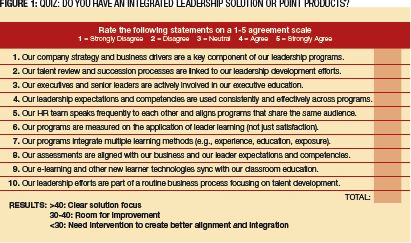Blended learning is the acknowledged solution of choice in corporate education. Consider all the bundled products that make up the typical leadership curriculum: e-learning and classroom education, quantitative instruments and qualitative feedback, manager mentors and executive coaches. We also have business school education and homegrown leadership training, action learning and learning portals, case education and the old-fashioned lecture.
Do the programs and products speak to each other, let alone the leadership audience? Do they reinforce the company strategy? Is leadership development a business routine or a one-time, big-ticket event?
These are difficult questions to answer and tough hurdles for any program to clear. Yet, if we hope to truly drive results — from both a business and learning perspective — we need to better align development products with each other and with the organization’s strategic agenda. Like the iPhone, a diverse set of applications should work seamlessly inside a common platform (Figure 1).

Leadership Programs in Practice
Many companies are turning core components of their leadership programs into compelling, harmonized leadership solutions.
Hewitt, an HR consulting and outsourcing company, is in its third year of a multiyear rollout of a leadership and management development curriculum. It includes the whole bag of blended learning tricks, but there is a difference. Mark Bocianski, Hewitt’s vice president of talent development, said, “Everything aligns with the core leadership expectations of our CEO — clients first, profitable growth, get lean and rewarding work experience. We develop the skills and knowledge associated with those expectations in a variety of ways, ranging from a typical leadership seminar to a completely online leadership development portal that we have delivered in partnership with Harvard University. But we want the content to be driven by the strategy, not the other way around.”
Tracy Keogh, Hewitt’s senior vice president of HR, said, “We need a strong leadership pipeline to fulfill our aggressive growth objectives. Traditional training programs that are informative and even entertaining are not enough to meet the demands of our talent management agenda. Our programs must not only sync to our strategy and vision, but also tell us something about the capabilities of individual leaders — so we can fast-track the best ones into our opportunity hot spots.”
Perhaps the most dramatic trend in leadership development over the past five years has been the use of executive coaches. Last year, 52 percent of Fortune 500 companies reported using coaches to promote leader development. Once reserved exclusively for the C-suite, today’s coaches work to support a broad range of leaders across functions and levels.
Unfortunately, the use of coaches across the enterprise has made the alignment and solution challenge that much greater. They are often left to fend for themselves on company strategy and even the performance and skill expectations of their clients’ roles.
Executive coach Ellen Kumata said, “There is a difference between coaching and strategic coaching. Coaching is working with leaders to understand and support the individual’s business challenges and development needs. Strategic coaching is getting all the coaches to enable the company’s vision through their work with individual clients.”
Specialty insurance company Assurant recently created Excelerate, a program to develop high-potential leaders more quickly. Executive coaches reinforce program content, support action learning projects and drive a unified leadership agenda.
“Excelerate builds upon our strategic framework, actively involves our senior executives and features professors from leading universities. From the start, we believed that coaches could tie everything together for the individual leaders,” said Carey Bongard, Assurant’s vice president of talent management.
Like coaches, professors are not an easy audience to bring under a common solution umbrella. They are hired for their unique expertise but are frequently challenged to relate their message to the company’s business picture and program content. Their celebrity and external perspective is what makes them so attractive to leaders and program sponsors. Yet the trick is making the benchmark or best-practice message work in the context of the company’s business agenda.
One way to ensure alignment is to have the executive staff co-teach with the university professors or consultants. Russ Fradin, CEO of Hewitt and a former McKinsey consultant, co-teaches the strategy and execution modules at Hewitt’s Global Leadership Forum with Don Sull, professor of management practice at London Business School, and Vijay Govindarajan, professor of international business at Tuck School of Business at Dartmouth.
“Our top leaders have to be absolutely in sync with our business strategy and value proposition,” Fradin said. “These folks get lots of communication from a variety of sources about what we care about — through talent reviews, business reviews, and performance discussions. That can lead to confusion. When I am teaching, there is no mystery about my expectations and message. I tell them what we are trying to achieve as a company and how I expect them to contribute.”
“The key to successful executive education is providing enough structure to focus a discussion on the issues that really matter, while leaving enough flexibility for the participants to bring their own concerns,” Sull said. “It is also important to give the participants an opportunity, in real time, to translate the insights from a session into concrete actions they can take back to their own operations.”
Action Learning, Developmental Assignments and Assessments
Action learning is a well-intentioned but frequently poorly executed way of bringing the work environment into the classroom. If done well, action learning projects promote team leadership, self-reflection and business results. If done poorly, they run the risk of being all action and no learning.
Albemarle Corp., a specialty chemical manufacturer, has made action learning a key feature of its leadership academy. Jahleel Stewart, Albemarle’s manager of global talent management, said, “We take a comprehensive approach to development with our leadership academy, including how we manage action learning and rotational assignments. However, more parts to the solution means more effort getting those parts to work together. The key to our success has been the active involvement of company leaders in creating challenging projects that have both business and leadership value.”
How challenging? How about taking 10 percent of the costs out of the operating budget of a major business unit or developing a competitive analysis of a rapidly changing Chinese market environment? Mark Rohr, Albemarle’s chairman and CEO and a presenter in its flagship leadership program, emphasized the dual value of these projects. “Sure, the projects have bottom-line value to the company and our shareholders, but I like the fact that it stretches our emerging leaders to demonstrate fresh thinking and present creative ideas to the management committee. It tells me something about the caliber of our succession candidates,” he said.
For developmental assignments, the same rule applies. The new roles are developmental in nature, not just short-term fixes to chronic bench strength problems. Darian Rich, Albemarle’s vice president of HR said, “Our biggest talent management challenge is addressing the global needs of our business. This isn’t a ‘nice to have’ situation where we want to expose U.S.-based managers to global markets with rotational assignments. We need outstanding managers to fill jobs in those markets and take up residence. We want to give our high-potential leaders an assignment that is developmental, but also one that will prepare them to take on global roles.”
Assessment is another important element of any leadership solution. Fidelity Investments is in the fifth year of its accelerated leadership development process for high potentials. Assessment plays a key role in this program, which also includes executive coaching, team development and action learning.
“Despite the upheaval in the financial services industry, we have remained focused on developing leaders at all levels,” said Holly Brittingham, director of leadership and organizational development for Fidelity. “We use a competency-based 360 assessment, Myers-Briggs Type Indicator, and a few other cognitive and conflict management instruments. However, we do it in a holistic manner with considerable support from our coaches. They help our leaders narrow in on a few key developmental messages, rather than get overwhelmed by all the data.”
“Instrumentation has its limitations,” said Fidelity coach John Poirier. “Adding context to the themes that result from 360 feedback is one of the most important things a coach can do. Fidelity has a framework of whole-person development that includes a leader’s character and aptitude as well as their business and functional expertise. This framework helps the coach take an inside-out and outside-in approach to helping leaders gain insight from feedback.”
The future role of assessments in leadership programs should include more coordination and alignment. There are a lot of assessments out there. The American Psychological Association counts dozens currently in widespread use in leadership programs. But, if they are going to be part of a leadership solution, they need to be managed against a broader objective than their individual construct or content validity.
What’s Next?
The trend toward solutions will continue with even greater emphasis on integrated technologies and platforms.
“All signs point toward a place where leadership solutions will be more global, flexible and interactive — without breaking the bank. There are new and disruptive technologies in place that are creating an open architecture for knowledge exchange. Webcasts, online platforms, RSS feeds and streaming video are pushing content quickly to anyone that wants to engage at a reasonable cost,” said Hewitt’s Bocianski.
“As our business continues to grow and expand geographically, our need for leaders at every level increases,” said Allen Walker, senior vice president of organization development and corporate communications at Assurant. “To meet this need, we must improve our ability to facilitate virtual interactions. Our goal is to make it much easier for a widely dispersed group of leaders to transfer knowledge, share best practices and build networks with peers.”
The Future Of Leadership Solutions
No one debates the importance of leadership education, even in tough economic times. The war on talent that captured everyone’s attention in the past decade will be reignited post-recession by retiring baby boomers and a shortfall of qualified succession candidates. The challenge we face today is straightforward but complex: How do we get the most out of our leadership investment while under intense cost pressure?
Turning a mix of loosely related programs into a leadership solution takes time, effort and creativity. Reduced budgets, new learning technology and a renewed emphasis on ROI will accelerate the transition to more efficient and integrated programs.
However, the inhibiting factors are equally formidable. The funding sources for leadership solutions will continue to be as diversified as the programs themselves. If someone has the cash to put on a program or launch an initiative in one part of the business, it will take a great deal of energy and political capital to bring it under an enterprisewide umbrella. Perhaps the most direct assault on solutions will come from universities, consulting firms and training houses that are legitimately interested in building their own brand awareness, sometimes at the expense of their corporate customers.
Despite these challenges, leaders are still optimistic. The tipping point will be greater cooperation among the wide range of partners and stakeholders in leadership education. Trainers and curriculum developers are already connecting with talent management planners. Coaches are working more closely with their corporate sponsors. And leadership teams are recognizing the importance of being deeply involved in the development of their successors.
The task ahead is building on this internal momentum and getting external partners to co-brand and collaborate rather than promote and differentiate. The most successful and forward-thinking partners have signed up already because they know that solutions are the pathway to verifiable business and learning results.
Jon Leatherbury is vice president of talent management and organizational development at Fiserv and John Hendrickson is a partner at Cambria Consulting. They can be reached at editor@clomedia.com.















